The Geometry of the Compactification of the Hurwitz Scheme
The Geometry of the Compactification of the Hurwitz Scheme
The Geometry of the Compactification of the Hurwitz Scheme
Create successful ePaper yourself
Turn your PDF publications into a flip-book with our unique Google optimized e-Paper software.
I V1 ⊆ I ⊆ P × G<br />
⏐ ⏐<br />
↓ ↓ ↙ ↘<br />
V 1 ⊆ P G<br />
Now let us consider <strong>the</strong> following diagram:<br />
Δ 12 , Δ 13 ⊆ C × C × C<br />
↙ π 12<br />
⏐ ⏐↓<br />
π 23 π 13 ↘<br />
(Diagram 6.2)<br />
C × C C × C C × C<br />
where <strong>the</strong> π ij ’s are <strong>the</strong> respective projections and Δ ij = π −1<br />
ij (Δ). Let us suppose that<br />
i, j are such that d − i − j>2g − 2. Let F (i,j) =(π1 ∗L)(−iΔ 12 − jΔ 13 ). Let K (i,j) =<br />
π 23,∗ F (i,j) .<strong>The</strong>nK (i,j) is a vector bundle on C × C <strong>of</strong> rank d +1− g − i − j. Note that<br />
we have a natural locally split injection K (2,2) →K (0,0) which gives rise to a morphism<br />
P(K (2,2),∧ ) → P(K (0,0),∧ )=C × C × P . Composing with <strong>the</strong> projection P ,wegeta<br />
morphism P(K (2,2),∧ ) → P which is clearly generically injective after taking <strong>the</strong> quotient<br />
by <strong>the</strong> action <strong>of</strong> Z/2Z permuting <strong>the</strong> two factors <strong>of</strong> C, and whose image consists exactly <strong>of</strong><br />
<strong>the</strong> bad divisors that appear in (3). <strong>The</strong> image is an irreducible variety V 2 <strong>of</strong> codimension<br />
2inP . Forming I V2 and σ 2 : I V2 → G as before, we see that σ 2 is generically injective,<br />
and that its image in G is some irreducible divisor D 2 whose points are exactly <strong>the</strong> bad<br />
lines that appear in condition (3). We shall compute <strong>the</strong> degree <strong>of</strong> D 2 in §6B.<br />
In particular, since G ≠ D 1<br />
⋃<br />
D2<br />
⋃<br />
D3 , we see that we can always construct a map<br />
α : C → P 1 with at most simple ramification. Thus ψ ◦κ is surjective. Note that instead <strong>of</strong><br />
working over k, <strong>the</strong>n, we could have worked over J d . In summary, we have <strong>the</strong> following:<br />
Proposition : <strong>The</strong> complement <strong>of</strong> κ(H) in G consists <strong>of</strong> three relative divisors D 1 ,<br />
D 2 ,andD 3 over J d , which are also geometrically irreducible over J d . <strong>The</strong>y correspond,<br />
respectively, to <strong>the</strong> linear pencils that fail to meet one <strong>of</strong> <strong>the</strong> conditions (2),(3), or(1)<br />
listed at <strong>the</strong> beginning <strong>of</strong> this §.<br />
§6.5. We now wish to relate <strong>the</strong>se divisors <strong>of</strong> G to <strong>the</strong> divisors <strong>of</strong> H constructed in §4.<br />
To do this, we shall need to construct some sort <strong>of</strong> map from H (or at least part <strong>of</strong> it) into<br />
G. This is a somewhat delicate task, which we now undertake.<br />
We shall call divisors at infinity <strong>of</strong> H ∼,+ or H + that lie over divisors <strong>of</strong> species X in<br />
H ∼ or H “divisors <strong>of</strong> species X”, as well. We propose to extend <strong>the</strong> map μ ′ : H + →H κ →G<br />
to a map μ : H ∼,+ →G. For any two distinct integers i and j between 1 and b, letus<br />
denote by U ij <strong>the</strong> open substack <strong>of</strong> H ∼,+ parametrizing admissible covers for which <strong>the</strong><br />
marking sections numbered i and j <strong>of</strong> <strong>the</strong> curve downstairs lie in <strong>the</strong> irreducible component<br />
<strong>of</strong> <strong>the</strong> curve downstairs which is <strong>the</strong> image <strong>of</strong> <strong>the</strong> curve <strong>of</strong> genus g upstairs. <strong>The</strong>n it is<br />
easy to see that, as i, j ranges over all admissible values, <strong>the</strong> union <strong>of</strong> <strong>the</strong> U ij is all <strong>of</strong><br />
54

















